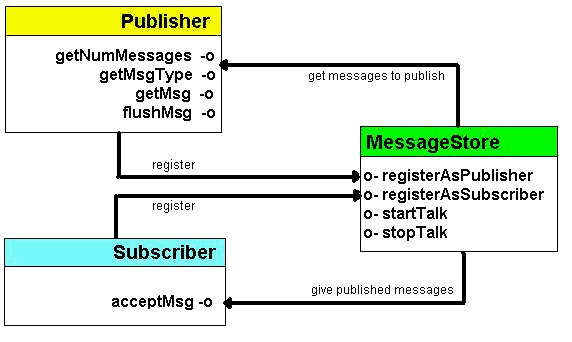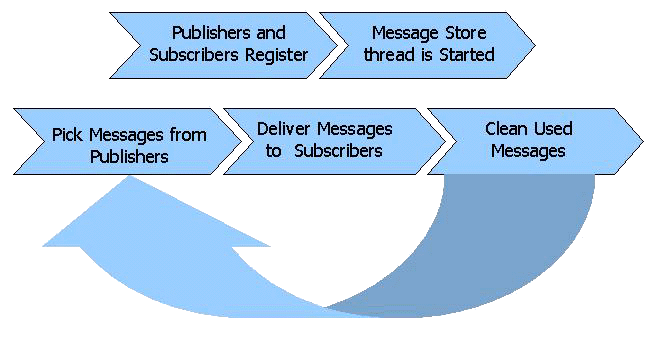|
Talkative
A framework to let diverse web applications
talk to each other through a common protocol.
INTRODUCTION
Consider a typical intranet situation. Let's say you have 5 intranet web
applications. Out of them 2 are Java applets, 2 more are ActiveX objects
and the remaining one is an application written using JavaScript. Some of
them are standard stuff and though they publish APIs to drive them from
other applications, you can not modify the application. How do you connect
them together? If you double click on an address book entry, it
should open the mail application with the selected address. How do you do
that?
Well, here's the answer. Talkative is a set of
Java, COM and JavaScript libraries which together can provide connectivity between
different kinds of applications. It provides the basic messaging infrastructure.
Applications can either be written to adhere to this protocol or wrappers can be
written over existing applications to be Talkative.
ARCHITECTURE
Talkative is based on a publish - subscribe model. The is a central messaging engine
which collects messages from all publishers and delivers them to the subscribers at
regular intervals. Publishers and subscribers must adhere to a published interface
to enable themselves being called by the messaging engine.

Components
The core delivery system is developed using Javascript. Javascript is theuniversal glue - available in most of the browsers and has access to to the completeDOM (Document Object Model), including any Java and ActiveX objects. An application has to register with the delivery system supplying a class and whether it wants to publish or subscribe.
Helper libraries have been provided for certain common development languages to ease the development of applications that adhere to this protocol. However, it is not
mandatory to use these libraries. It is enough as long as the classes implement the
required interfaces. A single class can both be a publisher as well as a subscriber.
A Message is characterized by a message type and the content string. Bothmessage type and content are strings, though typically the message type will be a shortidentifier string. A subscriber subscribes for one or more message types. A publisher canpublish one or more message types.
Message Flow
The infrastructure starts with publishers and subscribers registering themselved with
the messaging engine (using the register methods). The engine thread is then started by
the containing HTML page using the startTalk method. After this the infrastructure is
active and running. Publishers may start publishing messages and the messaging engine will
deliver them to the subscribers. Publishers and subscribers may also register while the
system is active and running.

The messaging engine keeps a list of publishers and subscribers. At a regular
(configurable) interval, it checks with each publisher for new messages, retrieves them
and stores them internally. Then it goes through the list of subscribers and delivers
the revevant messages to them. Once a message is delivered, it is marked as used. After
one round of operation, all used messages are cleaned up from the system and the message
store goes on for the next round.
HELPER (SAMPLE) LIBRARIES
The following libraries are provided. Some of them can be
used directly for any purpose. Some need to be modified to suit the exact purpose of usage.
Java Library
A class that can be used to subscribe or publish messages
from Java applets. This provides the interface required by the
delivery system. An instance of this class needs to be registered
with the delivery system. Save the code below as jtalk.java and
compile it to create a class file. The source code and the classes
are also included in the downloadable zip file
provided.
import java.util.Vector;
public abstract class jtalk
{
Vector vectMsgType = new Vector();
Vector vectMsg = new Vector();
public void acceptMsg(String sMsgType, String sMsg)
{
// override this method to handle messages
}
public int getNumMessages()
{
return vectMsgType.size();
}
public String getMsgType(int iMsgIndex)
{
return (String)vectMsgType.elementAt(iMsgIndex);
}
public String getMsg(int iMsgIndex)
{
return (String)vectMsg.elementAt(iMsgIndex);
}
public void flushMsg(int iMsgIndex)
{
vectMsg.removeElementAt(iMsgIndex);
vectMsgType.removeElementAt(iMsgIndex);
}
// call this function to store messages that will be retrieved by the
// talkative routines
void publishMessage(String sMsgType, String sMsg)
{
vectMsgType.addElement(sMsgType);
vectMsg.addElement(sMsg);
}
}
|
The JavaScript Library
A class that can be used to subscribe or publish messages
from JavaScript soutines. Save the code below as jtalk.js.
Modify the acceptMsg method as per the requirement. The source code
is also included in the downloadable zip file
provided.
<!--
var msgTypeArr = new Array();
var msgArr = new Array();
// modify this function to handle messages the way you want.
function acceptMsg(sMsgType, sMsg)
{
document.forms[0].recvdString.value = "Message Type: " + sMsgType + ", " + "Message: " + sMsg;
}
function getNumMessages()
{
return msgTypeArr.length;
}
function getMsgType(iMsgIndex)
{
return msgTypeArr[iMsgIndex];
}
function getMsg(iMsgIndex)
{
return msgArr[iMsgIndex];
}
function flushMsg(iMsgIndex)
{
var newMsgTypeArr = new Array();
var newMsgArr = new Array();
var iSize = msgTypeArr.length;
var iIndex;
var iNewIndex;
for(iIndex=iNewIndex=0; iIndex < iSize; iIndex++)
{
if(iMsgIndex == iIndex) continue;
newMsgTypeArr[iNewIndex] = msgTypeArr[iIndex];
newMsgArr[iNewIndex] = msgArr[iIndex];
iNewIndex++;
}
msgTypeArr = newMsgTypeArr;
msgArr = newMsgArr;
}
// call this function to store messages that will be retrieved by the talkative routines
function publishMessage(sMsgType, sMsg)
{
var iSize = msgTypeArr.length;
msgTypeArr[iSize] = sMsgType;
msgArr[iSize] = sMsg;
}
// this function retruns a class that can act as a listener as well as
// publisher. Call methods in this class to publish your messages
function getClass()
{
this.acceptMsg = acceptMsg;
this.getNumMessages = getNumMessages;
this.getMsgType = getMsgType;
this.getMsg = getMsg;
this.flushMsg = flushMsg;
return this;
}
//-->
|
The Visual Basic Library
A set of functions that can be included in a ocx to subscribe or
publish messages from Visual Basic ActiveX components. A sample Visual Basic
ActiveX control named Sample.ctl has been provided in the
downloadable zip file for implementation and
demonstration of Talkative. Create a ActiveX control project in Visual Basic
and add this source to the project.
Examples and Sources
Click here to download the sources for the
delivery system, libraries and the sample implementations along with a readme file.
Unzip the file into a directory and open Sample.html with Internet Explorer browser to
see the readymade sample application. Alternatively, you can click here
to open Sample.html.
List of files:
| Sample.html |
- |
The html file to test Talkative |
| talkative.js |
- |
The talkative engine written in Javascript |
| jtalk.java/jtalk.class |
- |
Java implementation of Talkative |
| Sample.java/Sample.class/jtalkimpl.class |
- |
Sample java applet for demonstration |
| jstalk.js |
- |
Sample Javascript implementation of Talkative demonstration |
| Sample.ctl |
- |
Sample Visual Basic ActiveX control for implementation
and demonstration of Talkative. Create a ActiveX control project in Visual Basic
and add this source to the project. |
|  Technical (Java Script)
Technical (Java Script) Technical (Java Script)
Technical (Java Script)